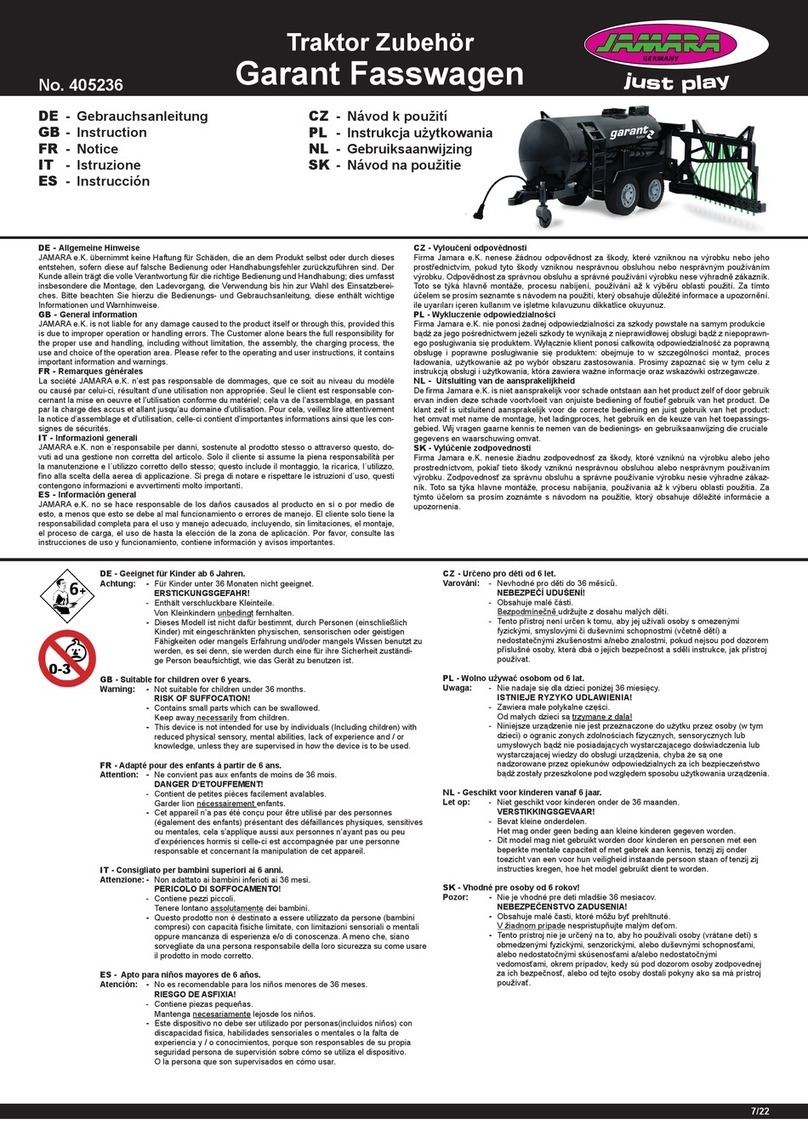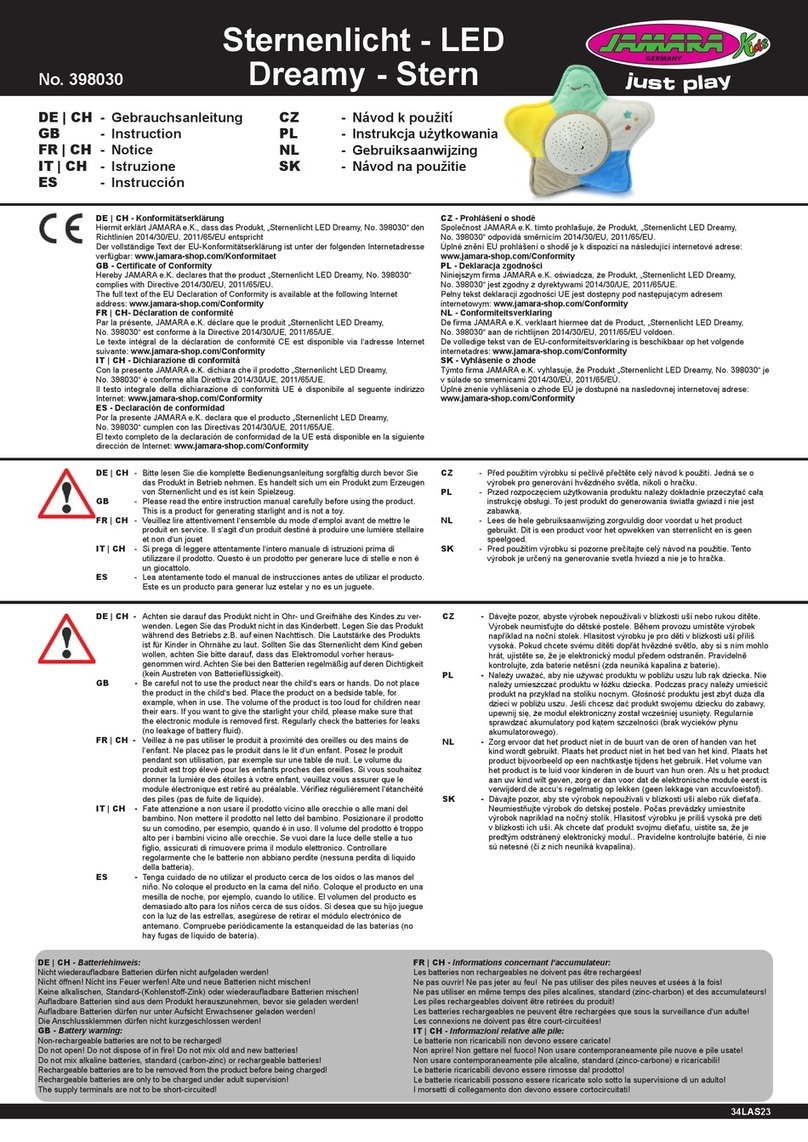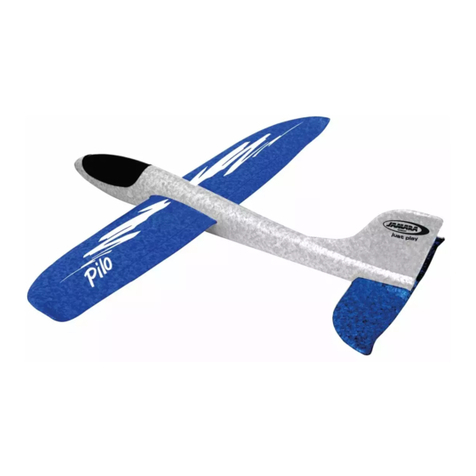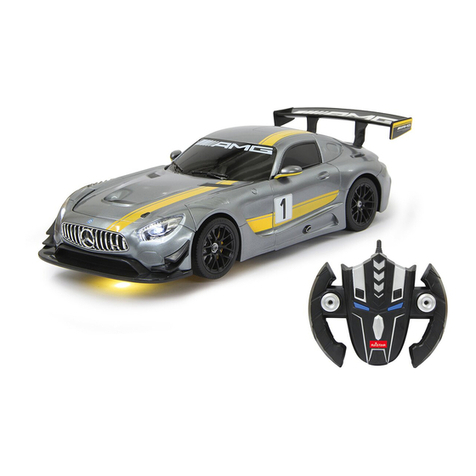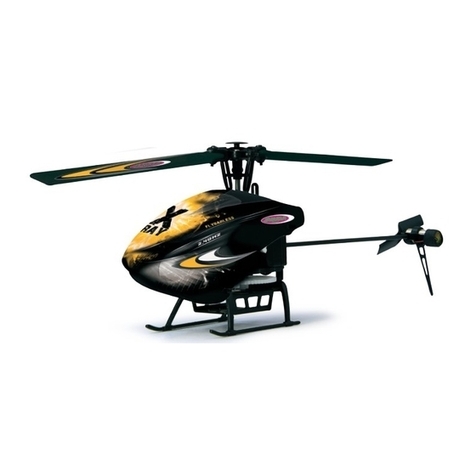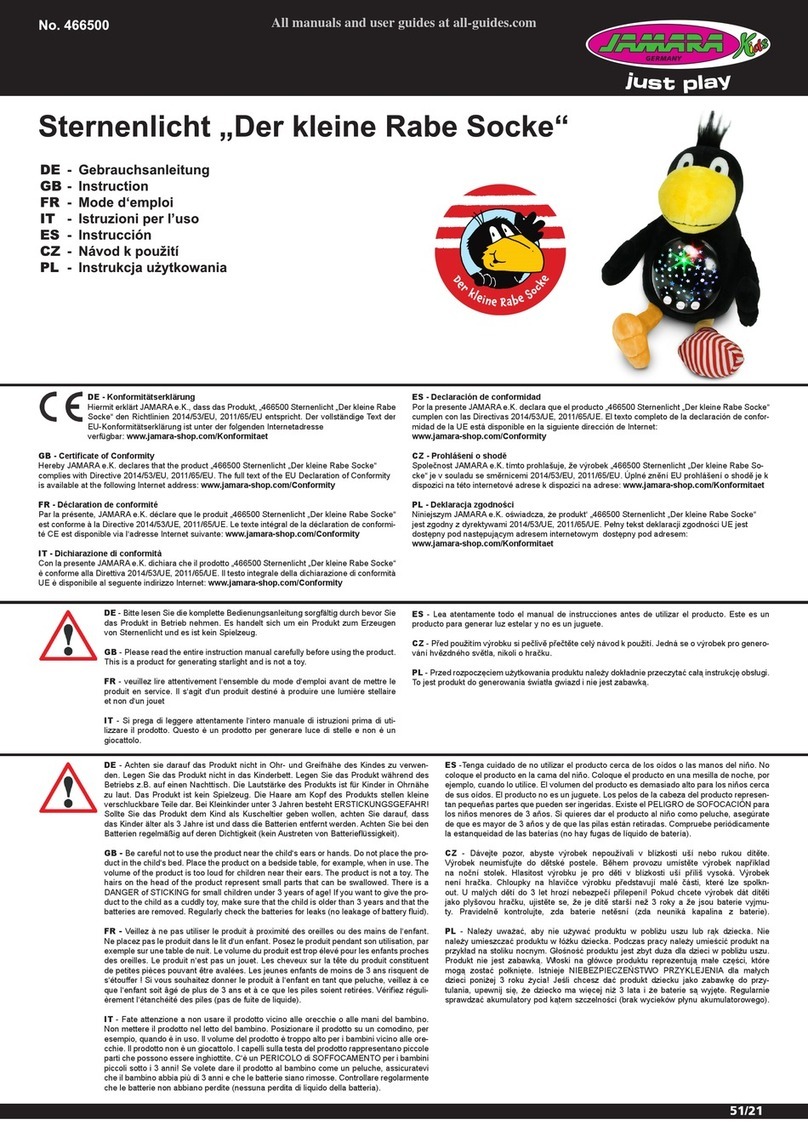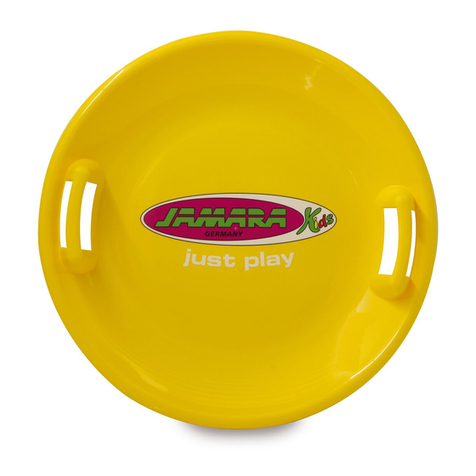
7
DE - Sicherheitshinweise
• Bitte lesen Sie die Bedienungsanleitung und Sicherheitshinweise sorgfältig durch bevor Sie das Modell in
Betrieb nehmen.
• Dieses Gerät ist nicht dafür bestimmt, durch Personen (einschließlich Kinder) mit eingeschränkten physischen, sen-
sorischen oder geistigen Fähigkeiten oder mangels Erfahrung und/oder mangels Wissen benutzt zu werden, es sei
denn, sie werden durch eine für ihre Sicherheit zuständige Person beaufsichtigt oder erhielten Anweisungen, wie das
Gerät zu benutzen ist.
• Der Benutzer ist im vollem Umfang für den richtigen Umgang mit dem Modell verantwortlich.
• Achtung: Gefahr von Augenverletzungen! Halten Sie einen Sicherheitsabstand von 1 - 2 Meter um sich oder andere
vor Verletzungen zu schützen.
• Jegliche Manipulation an der Struktur des Modells ist nicht erlaubt und führt zum sofortigen Verlust der Gewährleis-
tung.
• Fliegen Sie in keiner Umgebung mit mehr als +45°C und weniger als 10°C.
• Setzen Sie das Modell keiner direkten Sonneneinstrahlung, hoher Luftfeuchtigkeit oder Staubeinwirkung aus.
• Achten Sie darauf, dass manche Teile am Modell heiß werden können.
Betrieb
• Achtung! In einigen Ländern ist es vorgeschrieben für den (Indoor-) Betrieb eines Modells eine spezielle
Modellhalterhaftpichtversicherung abzuschließen. Informationen hierzu bekommen Sie bei den Modellsportver-
bänden oder bei einer Versicherung.
• Benutzen Sie das Fluggerät niemals in der Nähe von Flughäfen, Bahnanlagen oder Straßen. Halten Sie immer
ausreichend Abstand von den gefahrenträchtigen und besonders geschützten Bereichen.
• Betreiben Sie Ihr Modell nicht in der Nähe von Funkstationen, Hochspannungsleitungen, Transformatorkästen oder
ähnlichem! Diese Einrichtungen können Funkstörungen verursachen!
• Um Unfälle zu vermeiden, iegen Sie das Modell nie in der Nähe von Personen, Tieren oder sonstigen Hindernissen.
Hände, Haare und lose Kleidung vom Rotor entfernt halten. Nicht in die Rotoren greifen!
• Setzen Sie Outdoor-Modelle nur bei gutem Wetter ein. Bei Regen, Sturm oder gar Gewitter dürfen Sie diese Modelle
nicht betreiben
• Suchen Sie ein Fluggelände, das den gesetzlichen Voraussetzungen entspricht und frei von Hindernissen wie Bäu-
men, Häusern usw. ist.
• Aus Gründen der Sicherheit und um zufriedenstellende Flugergebnisse zu erzielen, ist auf einen ausreichend großen
freien Raum (ca. 6 x 5 x 2,5 m) zu achten. Dabei muss der Raum frei von Hindernissen (Lampen, losen Gegenstän-
den, etc.) sein. Außerdem sollte kein Luftzug vorhanden sein.
• Das Modell nicht aus großen Höhen fallen oder abstürzen lassen. Dies kann die Flugeigenschaften und die Lebens-
zeit des Modells beeinträchtigen.
Akkusicherheitshinweise
Durch die hohe Energiedichte (bis zu 150Wh/kg) sind die Zellen nicht ungefährlich und bedürfen einer besonderen
Sorgfalt! Die Firma JAMARA schließt daher ausdrücklich jegliche Haftung für Schäden aus, die durch den fehlerhaften
Umgang mit den Lithium-Polymer-Zellen entstehen.
• Bei unsachgemäßer Verwendung des Akkus besteht Brand- oder Verätzungsgefahr.
• Überladen, zu hohe Ströme, oder Tiefentladen zerstört die Zelle.
• Vor mechanischer Belastung (Quetschen, Drücken, Biegen, Bohren) schützen.
• Akkus keinesfalls öffnen oder aufschneiden, nicht ins Feuer werfen, von Kindern fernhalten.
• Behandeln Sie beschädigte oder auslaufende Akkus mit äußerster Vorsicht. Es können Verletzungen oder Schäden
am Gerät entstehen.
• Akkus auf keinen Fall kurzschließen und immer auf die richtige Polung achten
• Akkus vor Hitzeeinwirkung über 65°C schützen, fern von heißen Teilen (z. B. Auspuff) montieren.
• Vor der Lagerung (z. B. im Winter) die Akkus laden - nicht im entladenen und nicht im vollgeladenen Zustand lagern!
Bei längerer Lagerzeit sollte der Ladezustand gelegentlich kontrolliert werden.
• Der Inhalt der Zelle ist schädlich für Haut und Auge.
• Nach Hautkontakt mit viel Wasser abspülen und benetzte Kleidung ablegen.
• Nach Augenkontakt mit viel Wasser abspülen und einen Arzt konsultieren.
Sollte die Zelle sich überhitzen, aufblähen, rauchen oder brennen, darf dieses nicht mehr berührt werden. Halten
Sie Sicherheitsabstand und stellen Sie geeignete Löschmittel bereit (kein Wasser Explosionsgefahr, gut trocke-
ner Sand, Feuerlöscher, Löschdecken, Salzwasser).
GB - Security instructions
• Read the instructions and security instructions carefully before using the model.
• This product is not intended for use by individuals (including children) with reduced physical, sensory or mental
capabilities or lack of experience and / or knowledge, unless they are supervised by a person responsible for their
safety and is able to give instructions about how the product should be used. Children should be supervised to ensure
that they do not play with the product.
• The User is fully responsible for the correct use of the model.
• Warning: Risk of eye injury! Keep a safe distance of 1 - 2 meters to yourself or others to protect against injury.
• The model should not be changed in any way, doing so will invalidate the guarantee.
• Do not y in temperatures above + 45° C or below 10° C.
• Protect the model from strong sunlight, moisture and dust.
• Be aware that some parts of the model may get hot.
Operating
• Attention! In some countries it is a legal requirement to carry third party indemnity insurance when operating a radio
controlled model. Please ask your local dealer, governing body or your insurance company for details.
• Never use the model near an airport, railway or roads. Always keep a safe distance from potentially hazardous and
specially protected areas.
• Do not operate your model near radio stations, power lines, transformer boxes or similar facilities! This can result in
radio interference, causing loss of control over the model.
• It must be observed that neither persons or animals or other obstacles are within the operating enviroment.
Keep hands, hair and loose clothing away from the rotor, not reach into the rotors.
• The Outdoor-model can only be own in good weather. Do not y in wind, rain or thunder storms.
• Find a place to y which complies with any laws, and is free from obstacles such as trees, houses and / or other
obstacles.
• To ensure safety and for best results, the model may only be own in a large open room (~ 6 x 5 x 2,5 m), free of
obstacles such as lights or furniture. In addition, no draft should be available.
• Do not let the model fall or crash from high height. This may affect the ight characteristics and lifetime of your model.
Safety precausions for battery
Because of the high power compactivity (up to 150 Wh/kg) the cells are quite dangerous and need special care! The
company Jamara excludes explicitly, all types of liability for damages, that can occure when using the Lithium-Polymer-
Cells indequate.
• When using the battery incorrect there is a risk of getting re or acid-injuries.
• Overcharging, too high power, or discharging at low level destroys the cell.
• Protect from mechanical stress (squeezing, pushing, bending, drilling).
• Never open or cut batteries, do not throw into re, keep away from children.
• Handle damaged or leaking battery with care. Injuries or damages to the product can occure.
• Under no circumstance short-circuit the device and always watch out for correct polarity.
• Protect batteries from heat above 65 °C , mount away from hot objects (for example exhaust pipe).
• Before storing batteries (for example in the winter) charge the battery. Do not store in fully charged or in non charged
state!
• The contents of the cell is harmfull for skin and eye.
• If the content comes into contact with skin, clean with plenty of water and take off moisted clothes.
• If the content comes into contact with the eyes, clean with plenty of water and consult a doctor.
If the cell overheats, swells, burns or smoke is coming from it, do not touch it under any circumstances. Keep
away in a safe distance and prepare adequate extinguishing agents such (No water explosion, well dry sand,
re extinguishers, re blanket, salt water).
FR - Consignes de sécurités
• Veillez lire attentivement la notice et sécurités d’utilisation avant d’utiliser!
• Ce dispositif n‘est pas destiné à être utilisé par des personnes (y compris les enfants) dont les capacités physiques,
sensorielles ou mentales ou manque d‘expérience et / ou les connaissances pour être, sauf s‘ils sont surveillés par
une personne responsable de leur sécurité ou reçu des instructions sur la façon dont l‘appareil doit être utilisé. Les
enfants doivent être surveillés pour s‘assurer qu‘ils ne jouent pas avec l‘appareil.t.
• L’utilisateur prend la responsabilité entière du correct maniement du modèle.
• Attention: Risque de blessures à l‘oeil! Distance de sécurité d‘au moins 1 à 2 mètres à eux-mêmes ou d‘autres
protègent contre les blessures.
• Manipulez les éléments endommagés avec énormément de précautions. Des brûlures acides ou des dommages sur
l‘appareil. Sont à craindre.
• Ne volez pas si l‘air ambiant fait plus de +45°C ou moins de 10°C.
• N‘exposez jamais votre modèle directement dans les rayons du soleil, ne l‘utilisez pas par temps avec humidité
relative élevée ou dans un endroit plein de poussière.
• Attention, certaines pièces de votre modèle peuvent chauffer.
Mise en marche
• Attention ! Dans quelques pays il est nécessaire de souscrire à une assurance spéciale si vous souhaitez utiliser
des modèles réduits. Pour avoir plus d‘informations à ce sujet, veillez vous adresser au club de modèles réduits le
plus proche ou un organisme d‘assurance.
• N‘utilisez jamais votre modèle volant dans les environs d‘un aérodrome ou aéroport, installations de chemins de fer
ou de routes. Gardez toujours une distance sufsante par rapport au zones de dangers ou protégées.
• N’utilisez jamais votre modèle dans les environs de stations d’émissions, lignes à haute tensions, transformateurs ou
équi valent! Ces installations peuvent provoquer des perturbations et entraîner la perte du contrôle de votre modèle
ou même du modèle lui-même!
• Aucune personne, aucun animal ou outre obstracle ne dolvent se trouter dans l‘espace de fonctionnement de
modèle. Gardez les mains, cheveux et vêtement à bonne distance des parties en rotations, pas la main dans les
rotors.
• N’utilisez votre modèle outdoor que par temps ensoleillé. Surtout pas s’il pleut, s’il y a beaucoup de vent ou lors d’un
orage.
• Choisissez un terrain répondant aux exigences des textes de lois en vigueur pour faire évoluer votre modèle et libre
de tout obstacle comme par exemple arbres ou maisons etc.
• Pour des raisons de sécurités et an de proter pleinement du plaisir en vol, veillez à toujours utiliser votre modèle
dans un endroit ayant sufsamment de place (~ 6 x 5 x 2,5 m) pour évoluer. Pour cela il est conseillé d‘avoir le moins
d‘obstacles possibles (lampes, bibelots,…) pouvant être fatal pour votre modèle. Uniquement utiliser à l‘intérieur, à
l‘abri des courants d‘air.
• Ne pas laisser tomber le modèle de hauteurs élevées; ceci pourrait limiter les qualité de vol et la durée de vie du
modèle.
Consignes de sécurité de la accu
De part leur énorme densité énergétique (jusqu‘à 150Wh/Kg), les éléments Lithium ne sont pas sans dangers et né-
cessitent un soin accu! De ce fait, la société Jamara décline toute garantie pour les dégâts qui peuvent résulter d‘une
utilisation non conforme des éléments Lithium.
• Une utilisation non conforme peut déclencher un incendie ou des brûlures acides.
• Surcharge, des courants trop élevés ou une trop grande décharge détruisent les éléments.
• Protégez les éléments contre des chocs mécaniques (pincement, pression, torsion, perçage).
• N‘ouvrez ou ne découpez en aucun cas les accus, ne les jetez pas dans le feu, et tenez les à bonne distance des
enfants.
• Manipulez les éléments endommagés avec énormément de précautions. Des brûlures acides ou des dommages sur
l‘appareil. Sont à craindre.
• Ne court-circuitez en aucun cas les accus et veillez à toujours respecter la bonne polarité.
• Protégé les accus d‘une température au-dessus de 65°C et eloignez ceux-ci de corps chauffants (par ex.: pots
d‘échappements).
• Chargez les accus avant stockage (par ex.: en hivers). Ceux-ci ne doivent pas être ni dans un état déchargé ni
pleinement chargé.
• Le contenu des éléments est très dangereux pour les yeux et peau.
• Après un contact avec la peau, rincez la zone avec beaucoup d‘eau et enlevez les vêtements touchés.
• Après un contact avec les yeux, rincez avec beaucoup d‘eau et consultez un médecin.
Si les éléments venaient à surchauffer, goner ou prendre feu, il ne surtout plus les toucher. Tenez-vous à
bonne distance de celles-ci et cherchez un extincteur adapté (Pas l‘eau (risque d’explosion), ainsi le sable sec,
extincteur, l‘eau salée).
IT - Istruzioni per la sicurezza
• Vi preghiamo di leggere attentamente le istruzioni e Istruzioni per la sicurezza prima di
usare il modello.
• Questo prodotto non è destinato ad essere utilizzato da persone (bambini compresi) con capacità
siche limitate, con limitazioni sensoriale o mentali oppure mancanza di esperienza e/o di
conoscenza. A meno che siano sorvegliate da una persona responsabile della loro sicurezza o
ricevano istruzioni su come usare il prodotto in modo corretto. Bambini devono essere
supervisionati per assicurare che non giocano con l’apparecchio.
• L’utente é responsabile in pieno per il corretto utilizzo del modello.
• Attenzione: Rischio di lesioni agli occhi! Distanza di sicurezza di 1 - 2 metri per sé o per altri protezione contro
eventuali lesioni. Vola il modello mai in prossimità di persone.
• Ogni modica alle parti di un kit ne annulleranno la garanzia.
• Non volate con temperature superiori a 45°C e meno di 10°C.
• Non usate il modello direttamente ai raggi solari, ambienti troppo umidi, polverosi o troppo soleggiati.
• Assicurarsi che alcune parti del modello possono essere caldi.
Funzionamento
• Attenzione! In molti Paesi l‘ impiego di modelli radiocomandati richiede una assicurazione obbligatoria. Informatevi
perciò presso il vostro assicuratore o presso il vostro negoziante di ducia.
• Non utilizzare mai l´unita di volo nelle vicinanze di aeroporti, ferrovie o stazioni ferroviarie e strade. Mantenere
sempre una distanza di sicurezza adeguata dalle zone potenzialmente pericolose o di alta protezione.
• Non usate il modello nelle vicinanze di stazione radio, linea di alta tensione, casse di trasformazione oppure simile.
Queste installazioni causano disturbi frequenza che portano alla perdita del controllo no alla perdita del modello!
• Nel luogo di funzionamento non devono essere presenti persone o animali né ostacoli di alcun tipo.
Tenete mani, capelli e parti svolazzanti lontane dalle pale in rotazione, non toccare i rotori.
• Evitate di volare con vento forte, pioggia o temporale.
• Volate sempre in aree libere legalmente autorizzate, lontane da case, alberi e/o altri ostacoli.
• Fate volare il vostro modello lontano da ostacoli ed in uno spazio (~ 6 x 5 x 2,5 m) abbastanza grande da evitare che
il modello possa scontrarsi con ostacoli che lo danneggerebbero. Utilizzare esclusivamente in ambiente interno privo
di correnti d‘aria.
• Non lasciate che il modello precipita di una grande altezza. Questo può inuenzare le caratteristiche di volo e la
durata del modello.
Sicurezza della batteria
Dovuto al grande carico energetico (no a 150 KW/h le batterie Litio non vanno sottovalutate e prese alla leggera, ma
richiedono una particolare cura. Per questo JAMARA e.K. declina ogni responsabilità sull‘ impiego di queste batterie e
dai danni che potrebbero derivare dal loro utilizzo.
• Un uso non appropiato di queste batterie può provocare incendi. E relative ustioni.
• I sovraccarichi ad alta intensità o le scariche profonde possono danneggiarle.
• Evitate le sollecitazioni meccaniche (schiacciare, piegare, forare.)
• Non aprite, non gettate nel fuoco e non lasciate vicino ai bambini
• Manipolate con molta attenzione le batterie danneggiate o con perdita di liquido. Possono causare danni alle
apparecchiature
• Non cortocircuitatele e vericate sempre che la polarità sia corretta.
• Vericate che non sorpassino mai i 65°C e non montatele vicino a fonti di calore ( tubi di scarico
dei motori o simili)
• Prima di metterle via per una sosta nel loro impiego, caricatele solo a metà. Non conservatele mai
a pieno carico. Durante il periodo di conservazione controllatele periodicamente.
• Il liquido contenuto nelle batterie é dannoso per la pelle e per gli occhi.
• In caso di contatto con gli occhi, lavate abbondantemente con acqua e consultate il medico
• In caso di contatto con la pelle, lavate con acqua e togliete immediatamente i vestiti che si siano
In caso che il pacco batterie si dovrebbe riscaldare troppo rapidamente, gonarsi, fumare o prendere fuco non
la prendete nelle mani e non toccatela. Mantenete und distanza di sicurezza e in caso di incendio, spegnarla
con polvere antifuoco oppure con sabbia (No, acqua, pericolo di esplosione, sabbia asciutta, estintore, coperta
anti incendio, acqua di mare).
ES - Seguridad
• Lea atentamente las instrucciones y seguridad antes de poner el modelo en funcionamiento!
• Es producto no es para personas (incluidos niños) con discapacidad física, mental y sensonriais. O ninguna
experiencia ni conocimiento, a menos que vayan acompañados de un responsable o recibir instrucciones ¿Cómo se
debe usar. Los niños deben ser supervisados para asegurarse de que no te metas con el producto.
• El usario es responsable en su totalidad para el uso correcto del modelo.
• Precaución: peligro de lesiones en los ojos! Distancia de seguridad mínima de 1-2 metros a sí mismos oa otros
protegen contra lesiones.
• Se prohíbe cualquier modicación de la estructura del modelo ya que anulará la garantía inmediatamente.
• Nunca vuele en entornos donde la temperatura sea superior a +45° o inferior a 10°C.
• No exponga el modelo a los rayos solares directos, a altos índices de humedad o entornos muy polvorientos.
• No olvide que muchas piezas del modelo pueden calentarse.
Operación
• ¡Atención! En algunos países es imprescindible suscribir una póliza de seguros especial con cobertura para la
práctica del aeromodelismo. Encontrará más información sobre esto en su club local o contactando con una
aseguradora.
• Nunca utilizar el aparato de vuelo cerca de los aeropuertos, ferrocarriles o carreteras. Mantenga siempre una
distancia segura de las áreas potencialmente peligrosas y especialmente protegida.
• No haga funcionar su modelo en las proximidades de las estaciones de radio,líneas eléctricas, cajas de
transformadores, o como! Esto signi ca que puede la interferencia de radio princi pal causa la pérda de control sobre
el modelo!
• En el entorno de funcionamiento no deben haber personas, animales ni otros obstáculos. Mantenga las manos y el
cabello lejos del rotor, no introduzca las manos en los rotores.
• Utilice el modelo outdoor solo cuando las condiciones atmosféricas sean Buenas. No debería utilizar el modelo si
llueve, hay tormentas o se prevén malas condiciones atmosféricas.
• Busque un espacio abierto, que cumpla con la normativa vigente, y libre de obstáculos como árboles, edicios y / o
otros obstáculos.
• Para garantizar la seguridad, se debe volar en las divisiones (~ 6 x 5 x 2,5 m) amplias y sin obstáculos, como
lámparas y muebles. Use el modelo sólo en un interior sin corriente de aire.
• No deje que el modelo cae desde una gran altura. Este puede afectar a las características de vuelo y la duración del
modelo.
Seguridad de la batería
¡Debido a su densidad energética (hasta 150Kw/Kg.), los elementos no son inofensivos y necesitan de unos cuidados
mínimos!. La empresa Jamara e. K., de manera explicita, declina cualquier responsabilidad sobre los daños causado o
derivados, por un manejo erróneo de las baterías Litio.
• Una utilización inapropiada conlleva riesgo de lesiones y/o incendios.
• Los elementos se dañarán por sobrecargas, corrientes muy altas, o descargas profundas.
• Proteja las baterías de golpes, dobleces, perforaciones, tensiones, etc.
• Bajo ningún concepto las abra o corte, no las arroje al fuego, manténgalas lejos del alcance de los niños.
• Si están oxidadas o pierden electrolitos, manéjelas con mucho cuidado. Pueden estropear el dispositivo o causarle
lesiones.
• Nunca las cortocircuite, respetando en todo momento la polaridad.
• No permita que se calienten a más de 65ºC, aléjelas de partes calientes (P. Ej., la salida del escape).
• Cárguelas antes de guardarlas (p.ej., en invierno) - ¡No las guarde descargada ni tampoco a plena carga!
Controle regularmente el nivel de carga durante los periodos de almacenamiento prolongados.
• El contenido de los elementos es dañino para la piel y los ojos.
• Si entra en contacto con la piel, lávese con agua y quítese la ropa usada.
• En contacto con los ojos, enjuáguese con abundante agua y visite al médico.
En caso de sobrecalentamiento de la batería, o cuando se ina, humea o empieza a quemarse, ya no debe
tocarse de ningún modo. Por favor manténga una distancia de seguridad y ponga a disposición agentes para
extinción adecuados (No hay peligro de explosión en el agua, arena seca, extintores, mantas, agua salada).






